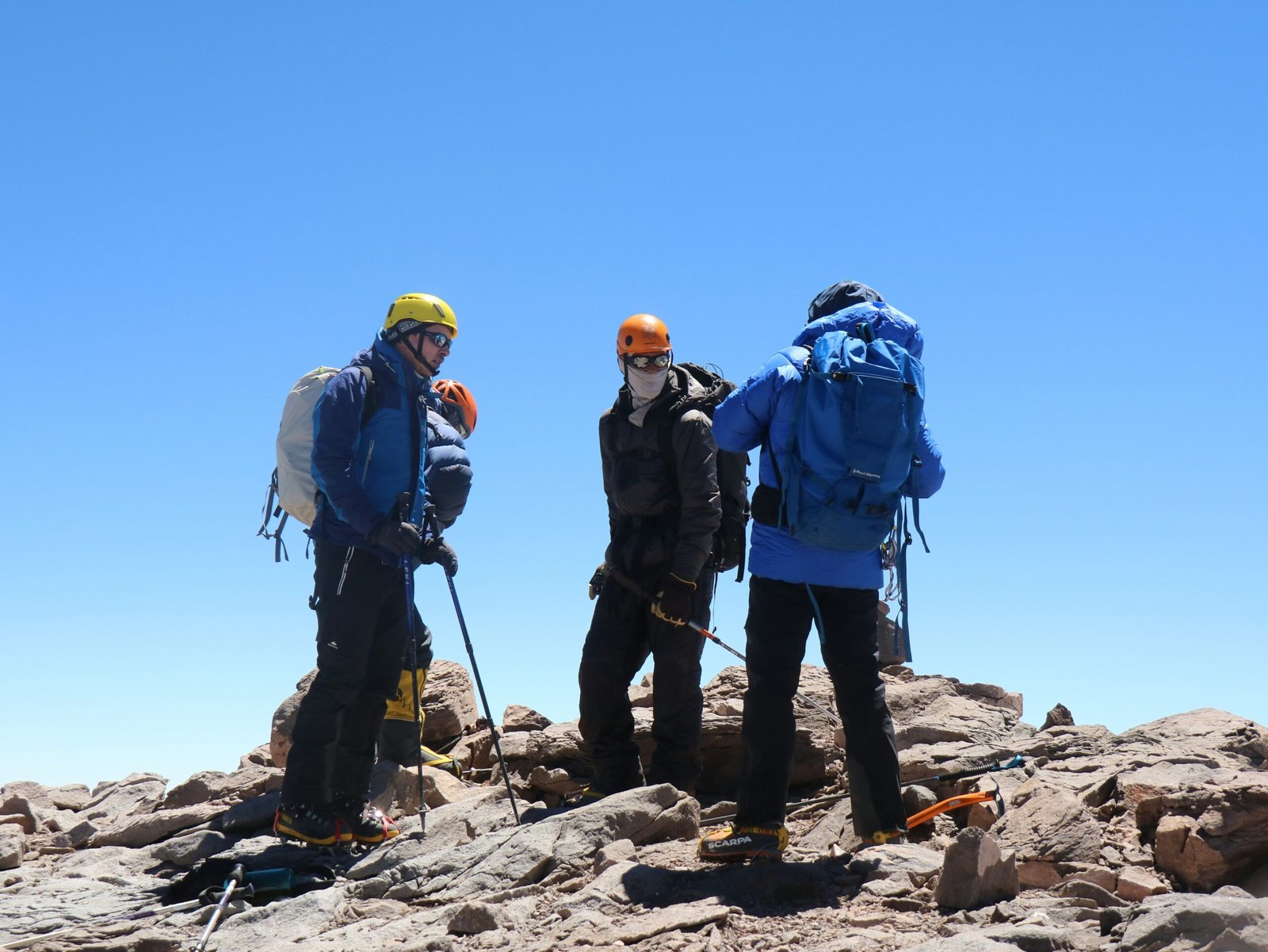Mount Kilimanjaro’s weather varies greatly depending on the altitude, season, and time of day. At lower elevations (2,000m – 3,000m), temperatures range from 15°C to 25°C (59°F – 77°F), with frequent rainfall, creating a humid, rainforest environment. As you ascend to mid-elevations (3,000m – 4,500m), temperatures drop to between 5°C and 15°C (41°F – 59°F), and rainfall decreases, giving way to cooler, drier conditions with mild daytime temperatures and colder nights. Higher up (4,500m – 5,500m), temperatures range from -5°C to 5°C (23°F – 41°F), with strong winds and intense sunlight during the day, but very cold nights. At the summit (above 5,500m), temperatures plummet to between -10°C and -20°C (14°F – -4°F), with snow, ice, and harsh conditions. The best times to climb are during the dry seasons (January to March and June to October), when weather is clear and predictable, while the wet seasons (April to May and November to December) bring heavy rainfall, making the climb more challenging. Weather on Kilimanjaro affects the experience, so it’s essential to prepare with layered clothing, sun protection, warm gear for cold nights, and rain gear, especially for the lower elevations.
Kilimanjaro Temperatures
Mount Kilimanjaro experiences a wide range of temperatures that vary significantly based on altitude, time of day, and the mountain’s five distinct ecological zones. At the base of the mountain, in the rainforest zone, temperatures are relatively warm, ranging from 70°F to 80°F (21°C to 27°C), with high humidity and frequent rainfall, especially in the afternoons. This zone is lush with dense vegetation, and while the days are warm, the nights tend to be cooler, requiring light clothing. As climbers ascend, they move through progressively cooler zones. In the mid-elevations, temperatures drop to between 50°F and 60°F (10°C to 16°C), transitioning into the heath and moorland zones where the climate becomes drier and the air thinner. Daytime temperatures are milder, but nighttime temperatures can fall significantly, often dipping below freezing. As climbers continue to gain elevation, reaching altitudes between 4,500 meters (14,763 feet) and 5,500 meters (18,045 feet), temperatures range from 30°F to 50°F (0°C to 10°C). In this higher region, known as the alpine desert, the weather becomes colder and windier, with minimal precipitation. Sun exposure can feel intense during the day, but the temperature still drops sharply at night, and it’s not uncommon for temperatures to plummet below freezing. The final stretch to the summit, which sits at 5,895 meters (19,341 feet), brings extreme conditions. Nighttime temperatures at the summit can range from -20°F to 20°F (-29°C to -7°C), with freezing cold, snow, and strong winds. The conditions on the summit are harsh, and the temperature can drop even further with the wind chill factor. These extreme conditions are often referred to as an arctic climate, with limited precipitation, mostly in the form of snow. The drastic temperature changes are primarily due to the high altitude, with temperatures dropping by around 1°C for every 150 meters (492 feet) of elevation gain. Climbers should be prepared for significant weather shifts as they ascend, and proper gear is essential to cope with the rapidly changing conditions. Although Kilimanjaro does not experience large temperature variations from season to season due to its proximity to the equator, the seasonal rainfall patterns do affect temperatures at lower elevations. During the rainy seasons, from April to May and November to December, the weather is wetter, which can make the trails muddy and slippery. The dry seasons, from January to March and June to October, are the best times to climb when the weather is generally clear, with lower chances of rain, making the overall conditions more manageable for climbers. Nonetheless, regardless of the season, climbers must be prepared for unpredictable weather conditions, as temperatures on Kilimanjaro can fluctuate dramatically, especially as they climb higher into the mountain’s more extreme zones.
Kilimanjaro Weather through the Climate Zones
Mount Kilimanjaro’s weather varies dramatically through its five distinct ecological zones, each with its own climate characteristics. These zones, from the base to the summit, include the rainforest, montane forest, heath, alpine desert, and arctic zones. The weather in these zones is influenced by altitude, with temperature and precipitation changing as climbers ascend the mountain.
1. Rainforest Zone (2,000m – 3,000m)
The lower elevations of Kilimanjaro are home to the rainforest zone, which is typically warm and humid. The temperature in this zone ranges from 70°F to 80°F (21°C to 27°C), with high humidity and frequent rainfall, especially in the afternoon. This zone is lush and teeming with life, from moss-covered trees to vibrant flowers and diverse wildlife such as monkeys and elephants. Although the days are warm, the nights can be cool, especially at higher altitudes within the zone. Climbers will often experience rain, making the terrain muddy and slippery, so it’s essential to have waterproof clothing and proper footwear.
2. Montane Forest Zone (3,000m – 4,000m)
As climbers ascend from the rainforest, they enter the montane forest zone, where temperatures begin to drop. In this zone, the temperatures range from 50°F to 60°F (10°C to 16°C), with drier conditions than the lower rainforest. The terrain is still forested but begins to open up into more sparse vegetation. Rainfall continues to occur, though it’s less frequent than in the rainforest. The air becomes thinner, and climbers might begin to notice the cooler, crisper air. The nights can be significantly colder than the daytime temperatures, and it is important to have warmer clothing for overnight stays.
3. Heath Zone (4,000m – 4,500m)
The heath zone marks the transition from forested areas to the more barren landscape above. Temperatures in this zone range from 30°F to 50°F (0°C to 10°C), and conditions become harsher as climbers move into higher altitudes. Rainfall is less frequent, but the air is still moist, and the climate is drier compared to the lower elevations. The vegetation in this zone includes heathers, giant groundsels, and lobelias, which are adapted to survive in the cooler, drier conditions. The wind picks up in this zone, and temperatures can drop significantly during the night, often dipping below freezing. Climbers will also experience more direct sun exposure during the day, but the nights remain extremely cold.
4. Alpine Desert Zone (4,500m – 5,500m)
In the alpine desert zone, the weather becomes cold and windswept. The temperatures range from 30°F to 50°F (0°C to 10°C) during the day but can fall below freezing at night. This zone is dry, with little precipitation, and is characterized by sparse vegetation, including hardy plants and occasional alpine birds. The air is thinner, and the landscape becomes barren and rocky. During the day, the sun can be intense, and climbers might feel hot in the direct sunlight, but the temperatures quickly drop once the sun sets. The winds also pick up at these higher elevations, which can make the already cold temperatures feel even colder.
5. Arctic Zone (5,500m and Above)
At the summit of Kilimanjaro, the weather reaches its most extreme. The arctic zone, where temperatures drop dramatically, is characterized by freezing cold, snow, and strong winds. Temperatures range from -10°F to 20°F (-23°C to -7°C) at night, with freezing conditions that can feel even colder with wind chill. The air is very thin, and oxygen levels are low, which can make the climb more challenging. Snow and ice are common in this zone, and climbers should be prepared for these harsh conditions. While precipitation is minimal, snowstorms can occur unexpectedly, and the temperature can rapidly drop, especially during the evening. The conditions are extreme, and only a few hardier species of plants and animals survive at this altitude.
Kilimanjaro Weather by Month
Mount Kilimanjaro experiences a tropical climate with distinct wet and dry seasons. However, the weather is influenced heavily by the altitude, meaning the temperature and conditions can vary greatly depending on the time of year and the elevation you’re at. Here’s a breakdown of the Kilimanjaro weather by month:
January – March: Warm and Dry
- Weather: January to March is one of the warmest and driest periods on Kilimanjaro. These months are considered ideal for climbing because there is little to no rain, and the skies are usually clear. The lower elevations (rainforest and montane forest zones) experience temperatures between 21°C and 27°C (70°F – 80°F), while the higher elevations (alpine desert and arctic zones) experience colder temperatures, ranging from -10°C to 5°C (14°F – 41°F) at night.
- Best For: Ideal for climbing due to the dry conditions and clear skies. You can expect minimal rainfall and favorable conditions for trekking.
April – May: Wet Season
- Weather: April and May are the wettest months on Mount Kilimanjaro. During this time, rainfall is heavy, especially in the rainforest and montane forest zones, where conditions become muddy and slippery. In the higher zones (heath, alpine desert, and arctic), the weather becomes colder, and snow may be present at the summit. Temperatures in the lower regions range from 19°C to 25°C (66°F – 77°F), and temperatures at higher altitudes range from -5°C to 5°C (23°F – 41°F).
- Best For: This is not an ideal time for climbing due to the increased likelihood of rain, slippery trails, and reduced visibility. It’s also more difficult to prepare for the cold, as the wet conditions make the journey more challenging.
June – October: Dry and Cool
- Weather: June to October marks the second dry season and is another excellent time to climb Kilimanjaro. These months are cooler than January to March, with temperatures ranging from 10°C to 20°C (50°F – 68°F) at lower altitudes. Higher up, temperatures range from -5°C to 5°C (23°F – 41°F) and can dip below freezing at night. While rain is less frequent, occasional light showers may still occur.
- Best For: Perfect for climbing due to the clear skies, dry conditions, and good visibility. While the temperatures are cooler, it’s still a great time for trekking, especially for those who prefer to avoid the heat.
November – December: Short Wet Season
- Weather: November and December mark the short wet season on Kilimanjaro. The rains are usually not as heavy as during the long wet season (April-May), but there are still frequent showers, particularly in the rainforest and montane zones. Temperatures at lower altitudes range from 19°C to 25°C (66°F – 77°F), while the higher zones will see temperatures around -5°C to 5°C (23°F – 41°F). This is typically a transition period from dry to wet weather.
- Best For: While the weather is more unpredictable, climbing is still possible. However, it’s important to be prepared for occasional rain and colder conditions, especially at higher altitudes.













